The curry tree is a tiny evergreen shrub or tree native to India and can grow to a height of six to twenty feet. The curry tree’s fragrant, spicy leaves are perhaps the plant’s most well-known aspect. The pinnate leaves grow alternately on the stalk. To get the most out of them, pick them up when they’re ready. Fragrant white blooms bloom on the tree before developing into tiny black fruits that resemble berries.
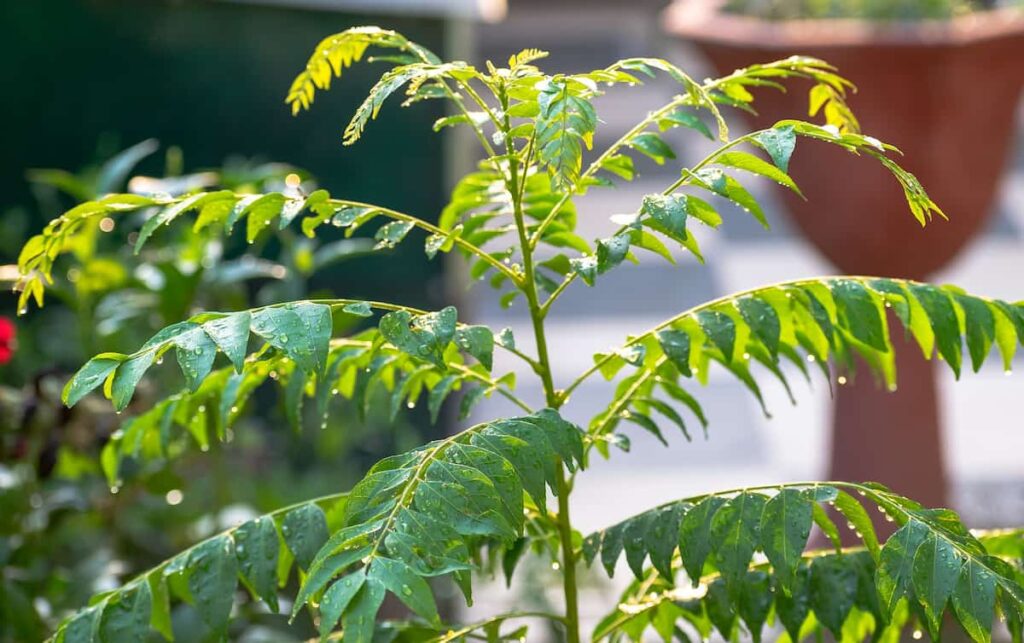
They can’t be eaten as the leaves can. An ideal time to plant a curry tree is in the spring. Below we learn how to grow curry leaf plants faster and the best tips for increasing your curry plants’ yield.
How to grow curry leaf plants faster
Choose a suitable location
The curry tree is native to the tropical areas of the Indian subcontinent. Because its weak trunk and limbs should not be planted in a very windy outdoor area. The only things that can kill this tree are prolonged periods of drought, abnormally high temperatures, or nutrient-depleted soil. After establishing itself in warm, bright, tropical circumstances, the curry tree grows to be a strong plant. The curry tree can only be cultivated successfully in cold locations if kept in a warm, humid environment. It can spend the summer and be brought inside when the temperature drops. Get ready for the plant’s overwintering by finding a good spot inside.
Plant the seeds carefully
Planting seeds will result in new curry leaf trees, but remember that this will not happen overnight. It can take up to two years for your plant to mature adequately for regular leaf picking. If you want your seeds to have the highest possible chance of germinating, you should buy freshly dried ones. Seeds that are too old have a poor chance of germinating. The seeds, essentially the pits of the berries, can be extracted by rubbing them vigorously between your hands to break apart the protective coverings.
If it doesn’t work, try rolling the seeds with a rolling pin inside a plastic bag. Soaking fresh berries for a full day will allow you to remove the seed easily. Once the seed has soaked, you can carefully wipe away the pulp and skin covering it. When starting seeds inside, ensure the potting soil is kept wet and spread the seeds a quarter of an inch deep. To keep the moisture in the container, you can cover it with plastic wrap with holes drilled. This will function like a little greenhouse.
Use a heating pad to maintain a soil temperature of 68 degrees Fahrenheit, the minimum required for seed germination. Because of their poor germination rate, it is recommended that many seeds be planted in each tray cell. Direct planting into the ground can be done outside when the average daily temperature is above 65 degrees Fahrenheit. Plants of average size need to be spaced at least four to five feet apart and at least that far away from any buildings.
Until the seedlings appear, which should be in approximately two to three weeks, be sure to keep the soil wet. To trim your curry leaf plant, wait until it is around six months old. When a healthy seedling develops six or more branches with numerous leaves, pinch back or trim two to stimulate bushier growth. The desired outcome is for the plant to develop into a bushy specimen with many offshoots rather than remaining slender and vertical.
In case you missed it: How to Grow Curry Leaf/Kadipatta Plant at Home: Check How this Guide Helps Beginners
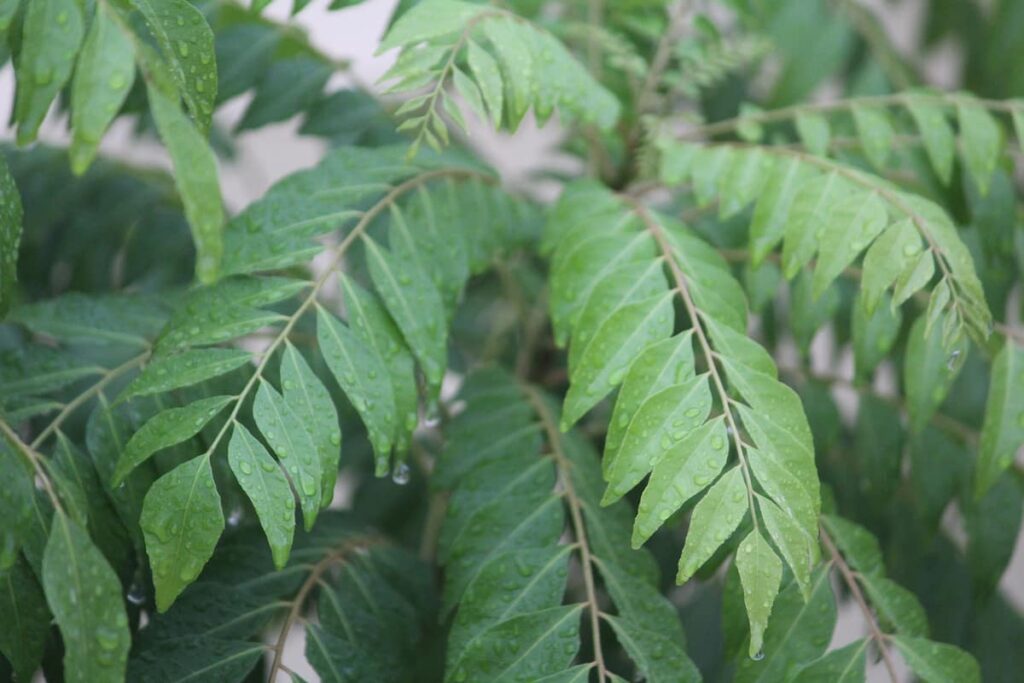
Using cuttings
Get a strong, mature plant in the spring and snip off three to six inches of its stem. This section of the stem should have three or more sets of leaves. The branch’s base should be cut at a 45-degree angle after being clipped as near as possible to the main stem. Rooting hormone powder can be applied to the bottom after removing the leaves. Put a soilless potting mix into a container. After the stem has been cut, a hole should be made in the potting soil and the cut end inserted.
Put it underground one inch or so. Put the container somewhere that receives sunlight for at least six hours daily from an indirect source. Mist the cuttings daily and maintain a wet potting mix until roots have formed. After approximately three weeks, the plant will be ready for transplanting if you give it a little pull and it resists. You can move the hardening process outdoors when nightly lows are above 40 degrees Fahrenheit.
To successfully transplant your curry leaf tree outside when the weather is warm enough, you must first harden off your roots by progressively exposing them to outdoor sunshine and wind. You should expose the plant to sunlight for one hour on day one. Two hours should be spent outside the next day. Repeat this process every three hours beginning on day three. Whether it will eventually be planted in the ground or placed in a container outside, within a week, it will be ready for its new home.
A mature standard plant’s typical height and spread are between six and fifteen feet. Maintain a spacing of four to five feet between them and nearby buildings or other plants. Pick a spot in your home that receives at least five hours of sunshine daily if you’re keeping your plant indoors. It shouldn’t be placed there immediately. To adapt your cutting to bright surroundings, you should expose it to direct light for increasing amounts of time over roughly a week.
Provide adequate water
After planting, the soil should be watered consistently for the first two months, and then it should be allowed to dry out after prolonged exposure to water (such as after a storm or prolonged irrigation). After then, regular, moderate watering is all that is needed. It is particularly important not to overwater throughout the winter. Plants growing in containers need to moisten their soil every two to four days. Leave the soil to dry out between waterings to prevent rotting.
In case you missed it: How to Grow Cantaloupe Faster: Best Tips to increase Flowering, Fruiting, and Production Yield
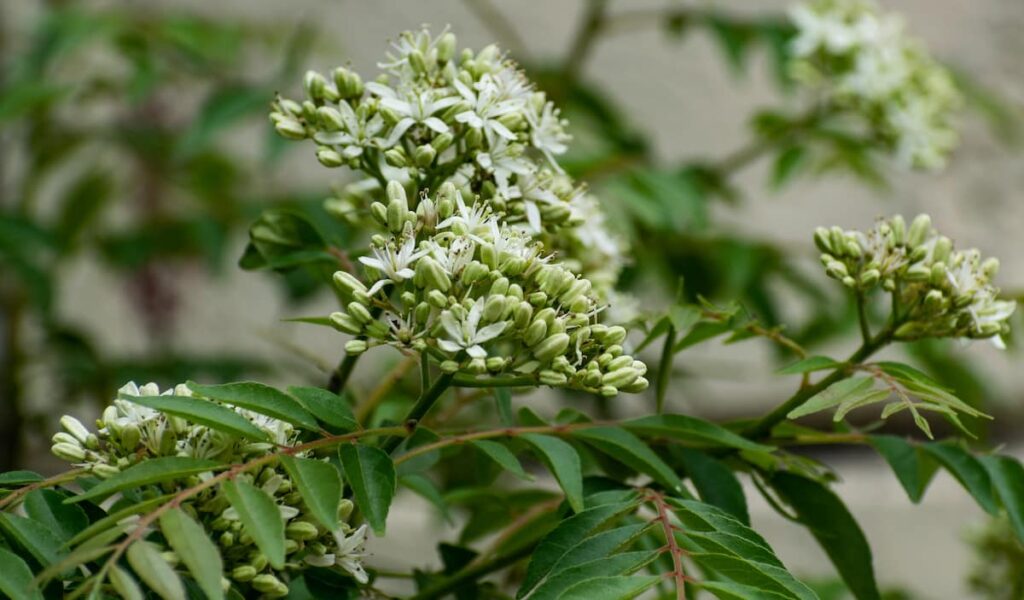
Fertilize your curry leaf plants
To have healthy young curry plants, you shouldn’t use much fertilizer. Fertilizer should be applied along the edge of the container. For outdoor cultivation, fertilizer applied to the crown of the curry plant is ineffective. Curry leaves benefit from liquid fertilizer applied every three to four weeks. To maintain foliage healthy, use iron sulfate or iron chelate every 4-5 weeks.
A fertilizer made from one teaspoon of Epsom salt dissolved in one liter of water can be used to speed up the growth of curry leaves. It is recommended that you fertilize your plant once every three months so that it may continue to produce healthy green leaves during the spring, summer, and autumn. Buttermilk can be used as fertilizer, and diluted curd is reportedly the finest homemade fertilizer for curry leaf plants.
Prune the curry plants leaves
One of the crucial tasks for fuller-looking curry leaves is cutting down the stems and branches of the curry leaves of plants. The more branches you give the plant by pruning, the more leaves it will produce. Pinch immature branch tips to stimulate bushy, fast curry leaf development. More leaves will be produced when they are harvested. The more you pick curry leaves from the plant throughout the spring, the bushier it will grow. Therefore it’s best to do this pruning then.
Repotting the curry leaves
The plant will have plenty of space to flourish after being repotted into a larger container. If you repotted your plant more than four months ago, you should still fertilize it, even if it doesn’t have any leaves (only left with a bare stem). You can count on it lasting through at least a few winters before needing any repairs. To ensure proper drainage, we must use high-quality potting soil. While repotting, consider the next pot size up and check that it has a drainage hole. When doing root trimming, ensure that you are using clean equipment to prevent the spread of disease from an infected plant.
Pluck the flower buds
Pick the flower buds as they appear on the plant’s branches. This will allow the curry plant to retain its energy for the growth of new leaves. We’ll have a problem if the plant produces more blooms than leaves.
In case you missed it: How to Grow Moringa Tree from Seeds in Backyard: Planting and Care in Winter
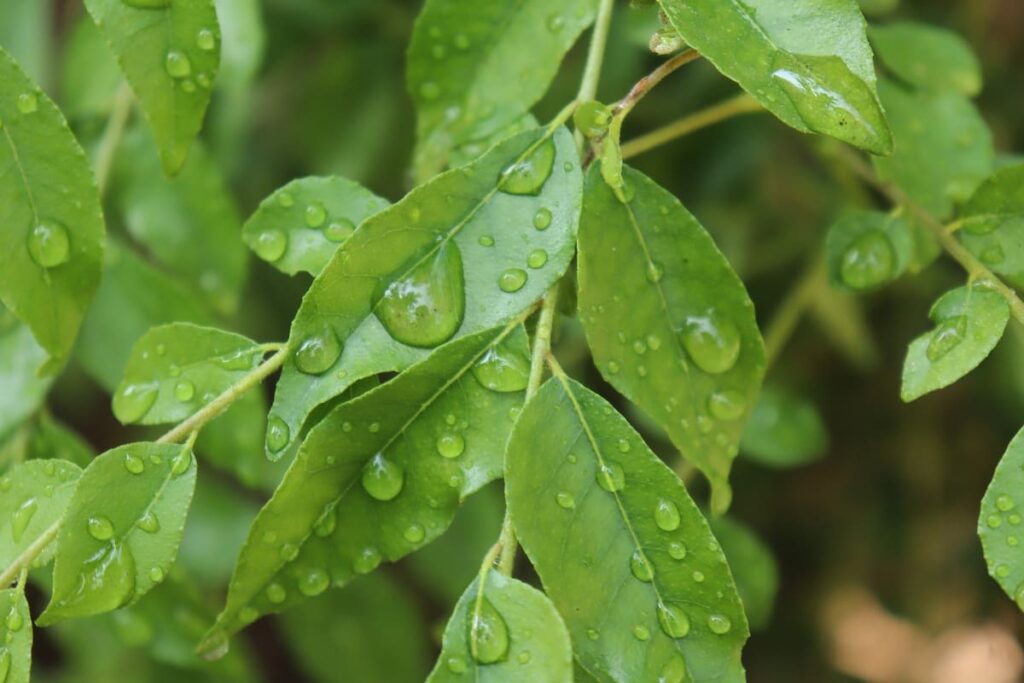
Overwintering your curry plant leaves
For the duration of the colder months, plants that produce curry leaves enter a dormant phase called winter dormancy. Low temperatures (more cooling) during the winter prevent the curry plant’s leaves from fully basking in the sunshine, which is the plant’s primary concern. The leaves might develop a golden color. This is a symptom of its transition into the dormant winter phase.
One of the most typical things with curry leaf plants in the winter is that when the temperature drops, the leaves fall off, leaving the plant with only a stem. Okay, so I’ve provided the solution to this problem. Reduce plant watering till spring. The plant will be aided in maintaining its dormant condition. The plant will thrive inside, near a south-facing window. Whenever there is no way to bring the plant inside, use a black blanket or something similar to raise the temperature within the container (where the roots are) by 5 degrees Fahrenheit relative to the outside.
Raise plant temperatures, reduce winter dormancy, and preserve curry plant leaves. The curry leaves should be in indirect sunlight and brought inside at night. No amount of subsequent care will save the plant if you fail to bring it indoors. You should take care not to forget. The curry plant requires attention if just the stem remains and no leaves have formed. In other cases, the plant can perish.
Your plant’s temperature can be raised by bringing it inside and positioning it near a window, where it will get enough sunshine. If that isn’t an option, you can try covering the plant with something black to bring its temperature down by around 5 degrees Fahrenheit relative to the outside air. Replace the cold water with warm. The plant producing curry leaves will benefit from this since its temperature will be maintained.
In case you missed it: How to Grow Okra Plants Faster: Best Tips to Increase Flowering, Fruiting, and Yield
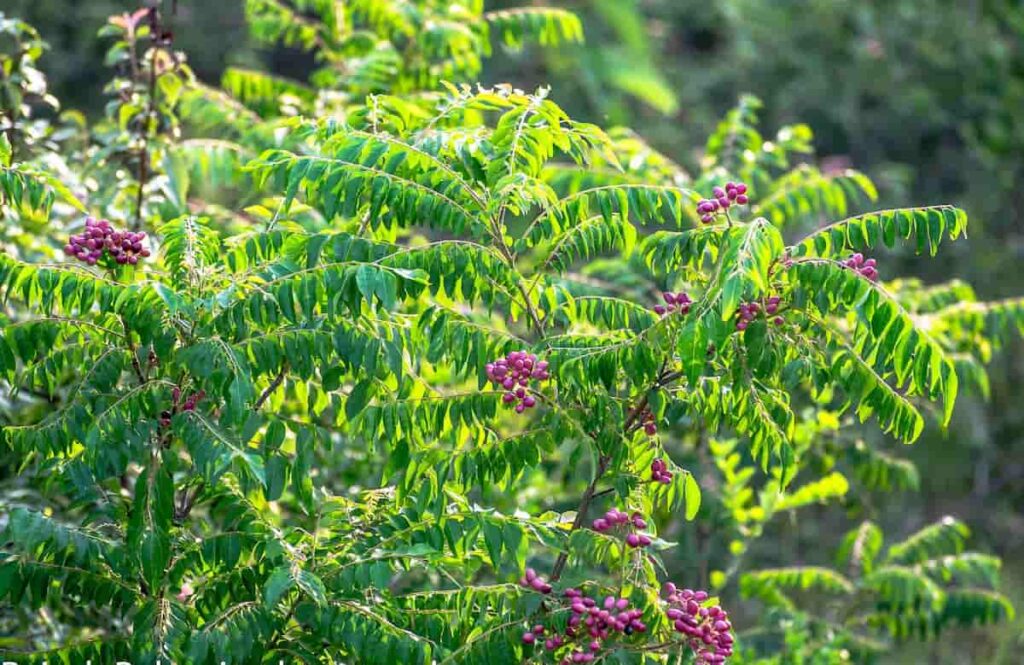
Controlling pests and diseases
Insects, known as aphids, love young plants. You’ll see clusters of small, wingless insects in various colors throughout the plants. They can transmit diseases and drain your plant of its vital nutrients. Curling and yellowing of leaves are two effects of their damage, and the sticky honeydew they leave behind might promote the growth of sooty mold. Plants should be sprayed with a strong stream of cold water as the first line of defense. It can be enough to knock them free and send them on their way to other plants.
Flour can be used as a backup strategy if that doesn’t help your plant. Applying neem oil once a week may keep pests away, but calling a professional is your best bet if the problem persists. Spider mites are a pest that can potentially affect plants. Although these small spiders might be difficult to see, their webs are easy to spot. As they pierce plants for food, they drain the moisture from the tissue, which can lead to wilting or necrotic patches. They also pose a health risk since they spread diseases.
As with the curry leaf plant, they thrive in warm climates. To get rid of this insect, spray the plants with cold water. Follow this routine for a whole week. If it doesn’t work, try restocking your garden with ladybugs and lacewings. When that fails, it’s time to bring in the major weapons. You can get rid of them by using neem oil or insecticidal soap. Use a soap or oil spray, as directed by the manufacturer, and apply it to your plants three times each week for two weeks.
Psyllids are sap-sucking insects that are related to mites and aphids. Curry leaves will turn yellow and fall off if the plant is fed too much. The length of this beetle is approximately a tenth of an inch, and it has a rusty brown tint. It can fly and leap great distances. The appearance of nymphs is similar to that of the common plant pest scale. Ladybugs and lacewings can help manage populations, as can frequent neem oil treatments. Spots on your plant’s leaves might be caused by bacteria or fungus, referred to as “leaf spots.”
Your curry leaf tree may eventually die if it contracts this illness, severely weakening and stressing the plant. The name suggests that it manifests as little brown or black dots on leaves. Stop fertilizing until a soil test reveals a particular nutrient shortage, which will be under control. Apply a mulch of grass, leaves, or newspaper around the tree, allowing a gap of two inches between the mulch and the trunk, and make sure your plant receives enough water.
Frequently asked questions about curry leaves
How can I grow curry leaves fast?
The growth rate of your curry leaves can be increased by using seaweed fertilizer every 15 days. There are more than 60 trace minerals found in seaweed and kelp fertilizers. Various growth hormones also make them useful as growth stimulants. These nutrients can be purchased in both liquid and powdered versions. If your diet is vegetarian, then you can cultivate your curry leaves but don’t want to use any fertilizers made from animals, consider using seaweed instead.
Which fertilizer is best for curry leaves?
In two years, standard types will have reached a height of six feet, making them ready for regular harvesting. It can take dwarf and miniature varieties up to five years to achieve a harvestable size of around half their maturity height. There are two methods for harvesting:
You can choose leaves according to your needs at any time. Alternatively, you can harvest more heavily twice or thrice yearly. With the second approach, you prune your tree every two months while it’s actively growing. Cut the branches back with some shears or pruners. Keep a space of a few inches under each limb. Take no more than half the leaves at a time.
In case you missed it: How to Build Raised Bed Garden from Scratch: Plan, and Design for Beginners

Why is my curry leaves plant not growing?
Keep the plant indoors throughout the winter, ideally near a window where it can receive indirect light. You should keep it out of the path of any heating draughts. Without water, the plant will wither. It’s safe to calm down; the plant won’t thrive inside. Even if it loses its leaves while it’s dormant, it’ll sprout new ones when spring arrives.
How often should I water curry leaf plant?
This plant only needs an inch of water each week during the spring and cooler months to thrive. But daily watering can be necessary for the warmer summer months to prevent the soil from drying up. When temperatures drop, the plant can go into a dormant state, so cutting down on watering is a good idea. The plant’s development can be stunted if the roots are allowed to sit in water, which can lead to root rot and other problems.
Conclusion
You should let the tree, preferably two, get established for at least a year before you prune it. When the plant’s foliage is thick and full, it can be harvested for its fragrant leaves. It is important to harvest plants regularly to promote their current and future development. The taste of curry leaves is at its most when they are fresh, so keeping a tree either inside or outside will ensure that you always have a steady supply.
- Broccoli Varieties: Choosing the Right Cultivars for Your Farm
- How to Raise Pigs in Your Own Backyard: A Comprehensive Guide
- Budget Friendly Sheep Shed Ideas: Cheap and Low-Cost Tips
- How Much Do Cattle Farmers Make: Revenue Streams in Cattle Farming
- Management Pests and Diseases in Your Cotton Field
- Sheep Farming Business Plan for Beginners
- Aquaponic Farming at Home: A Step-By-Step Guide
- Profitable Village Farming Business Ideas in 2024
- High-Yield Aquaculture: Fast-Growing Fish for Farming
- Effective Fish Pond Construction Techniques for Beginners
- Irrigation and Water Management in Pineapple Farming
- Blossom to Harvest: Mastering Flowering and Pollination in Papaya Farming
- Pig Fattening Essentials: From Selection to Sale for Beginners
- Raising Wagyu Cattle: A Complete Guide for Premium Beef Production
- Soil Types and Their Water Holding Capacity
- Optimizing Irrigation Schedules for Coconut Groves for Enhanced Yield
- Espresso Your Garden: Coffee Grounds for Healthier Acid-Loving Plants
- The Best Soil Mix for Snake Plants: How to Mix Your Own Snake Plant Soil
- Green Thumb Success: Expert Tips for Cultivating Greenhouse Beans All Year Round
- Bloom All Year Round: The Ultimate Guide to Indoor Hyacinth Care
- Eco-Friendly Gardening: How to Make Liquid Fertilizer from Kitchen Waste
- Ultimate Guide to Grow Anise in Pots: Explore Seed Propagation to Harvesting
- Guide to Raising Chester White Pigs: Discover Breed Facts to Growth Management
- Mastering the Elegance: The Ultimate Guide to Weeping Cherry Tree Care, Planting, and Maintenance
- Ultimate Guide to Planting Garlic in Grow Bags: Growing Strategies for Beginners
- How to Fix Spider Plant Leaf-Related Problems: Natural and Organic Remedies
- 10 Reasons Why Your Tulsi Plant is Shedding Leaves: Home Remedies and Solutions
- Optimizing Growth and Yield: The Advantages of Palm Bunch Ash Fertilizer
- Utilizing Neem Oil Extract as a Natural Pesticide for Hydrangea
- From Soil to Harvest: Various Ways in Which Farmers Can Use AI Tools
- Steps to Encourage and Induce Citrus Flowers: A Comprehensive Guide
- How to Fix Snake Plant Leaf-Related Issues: Natural and Organic Remedies
- Transform Your Garden into a Fragrant Oasis with Raat Ki Rani (Night Blooming Jasmine)
- Discover the Ideal Chicken Breeds for Philippine Farms
- How to Create a Poultry Egg Farm Business Plan for Profits
- Grow Lemon Cucumbers Like a Pro: Insider Techniques for Bountiful Yields
